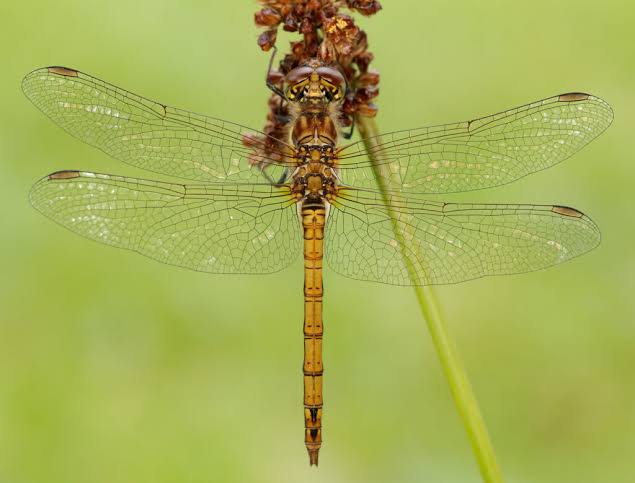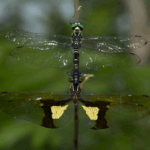Habitat
Commonly encountered, even away from water.Ponds and other still, stagnant or even brackish waters are used, and they are frequently found at small garden ponds.They are frequently found away from water, resting on the tops of plants in woodland rides.
Life History
This species like to perch on fences, twigs and wires whilst it searches for passing prey. It is able to remain active in lower temperatures than other species, partly by seeking out sunny spots to warm up in.
Further Information
The Common Darter is an abundant and widely distributed species in VC 55, being tolerant of many different habitat types. It is also a very dispersive species and is regularly encountered far from water. Historic records show that such abundance has always been the case, with Roebuck (1932) describing the Common Darter as ‘very common and widely distributed’.
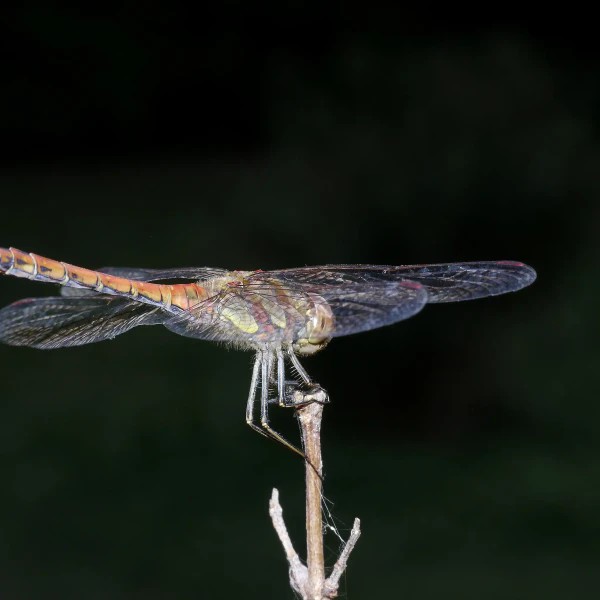
The most common species of Darter that can be found well into November.
Males: dull to bright orange-red, especially on the upper surface of the abdomen.
Females: ochre becoming duller/reddish with age.
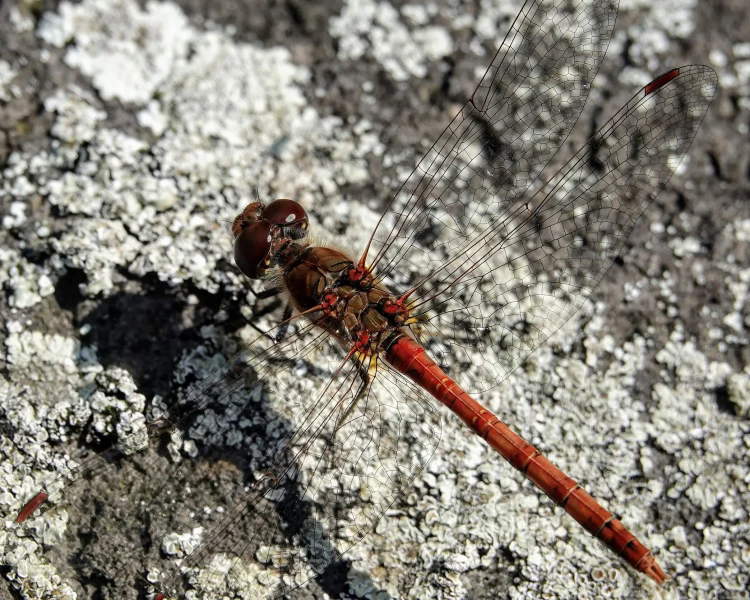
Sympetrum species are not easy to tell apart and in most areas more than one Sympetrum species will occur. Females and teneral individuals have light yellow thorax and abdomen. Males turn red as they mature. Females darken with age, becoming a dark chocolate brown, and sometimes develop a blue colouration to the bottom of the abdomen. The wings also develop a brown tinge with age. In all cases the legs have a cream or yellow stripe on a black background – this is a diagnostic feature of this species. The pterostigma of the females can be red, blue, pale blue or brown.
Habits and Lifestyle
Adults can be seen on the wing all year round in southern Europe but in northern regions they occur from June to November.
This small dragonfly is seen in a wide variety of habitats, including lakes, ponds, canals and slow-flowing rivers. They are ambush predators, waiting on a prominent perch – such as a leaf or the top of a gate, until prey fly past, whereupon they will fly after it. They are territorial on breeding waters, often attempting to chase much bigger dragonflies away such as southern hawkers. This habit of repeatedly returning to a sunny spot allows you to easily predict where they are going to land, which is why it is one of the easiest dragonflies to photograph.
In suitable hunting areas away from water, however, they are not territorial: large numbers may assemble – groups of several hundred in a single field have been recorded – and lines of insects can be seen along the top of field gates.
Eggs are not laid, but broadcast from the air: the male holds the female in tandem and swings her down and forward over water. At the furthest point of the arc the female releases some of her eggs to fall on the water.
Diet and Nutrition
Population Trend
Unknown
POPULATION STATUS
Least concern (LC)
ne dd lc nt vu en cr ew ex
Population
Population number
This is one of the most abundant dragonflies in Europe, and populations show no evidence of decline.
Common Darter or Ruddy Darter?
Sympetrum is a genus of small to medium sized dragonflies of which there are about 50 speciesliving in the temperate zones of the northern hemisphere. Two of the genus – Ruddy Darter(Sympetrum sanguineum) and Common Darter (Sympetrum striolatum) – breed at Marsh Lane.These two species share the same habitats at Marsh Lane and their flights periods overlap.Similarities in appearance cause some identification confusion but there are clear pointers in thedetail of each species that will enable separation.
Common Darter is, as its name suggests, one of the most common dragonflies in Europe. Theyare abundant in England, Wales and Ireland, less so in Scotland. At the start of their flight period – aroundmid June – a walk around the edge of Dragonfly Pool will put up a couple of dozen newly emergedCommon Darters. Towards the end of the summer Common Darters seem to be everywhere, with a fewstill on the wing at the start of November.
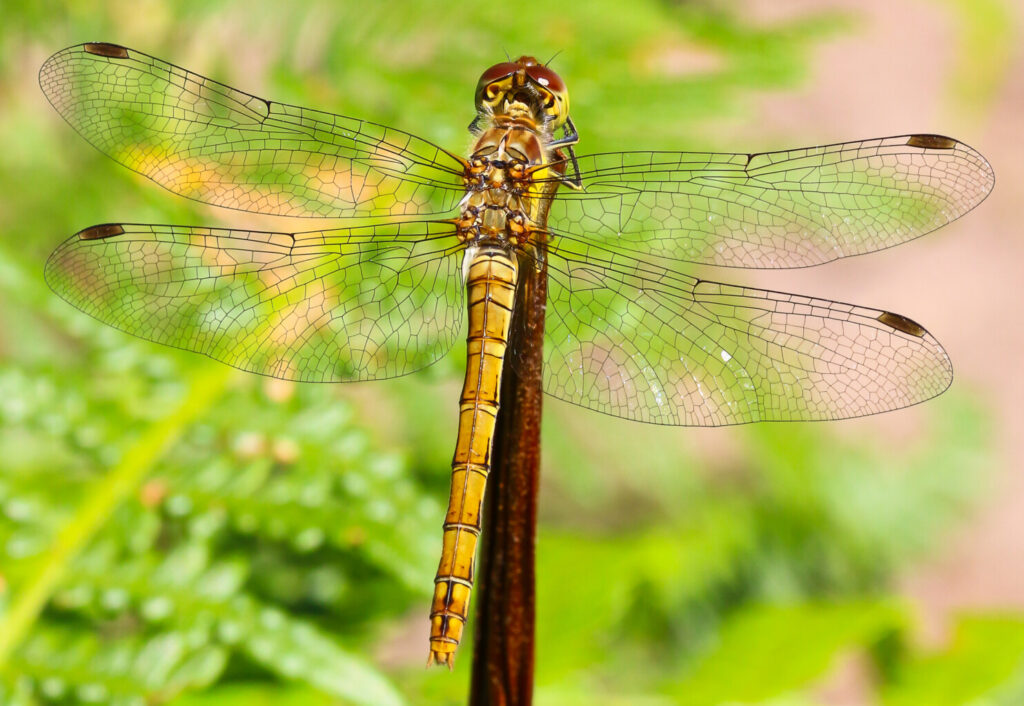
Ruddy Darter is found in the temperate regions of Europe as far east as Siberia and as far southas the northern Sahara. Its conservation status is secure, and UK numbers seem to be increasingin some locations such as central England. It prefers quiet bodies of water that feature semiaquatic vegetation such as rushes and reeds. Ruddy Darter are found across Marsh Lane reserve –around the car park, the causeway, and dragonfly pool in particular – but sightings are very low incomparison with Common Darter. As an indicator you may see no more than ten (if you’re lucky!) RuddyDarters – male and female – over the whole flight period (early June to early October). There’s probablymany more – but they’re elusive and may remain in the reeds around the fringes of the pools.
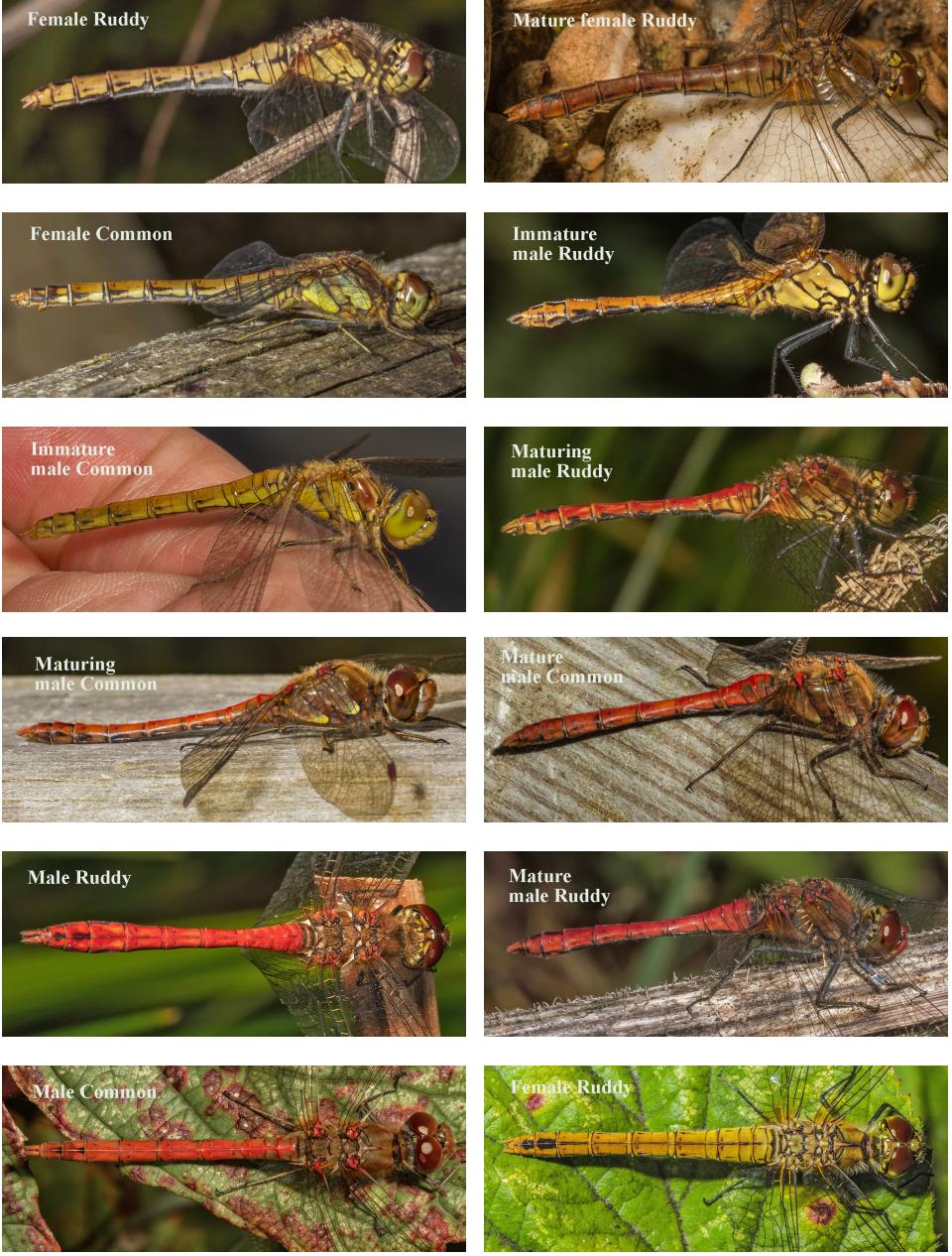
Comparing:The females of both species are very similar. Both are ochre yellow in colouring. The Common Darter isslightly larger but this is only useful if the two species are viewed together. Really the only way toseparate female Common and Ruddy Darters is to look at the legs, which will mean close examination.Common Darter has a yellow line running along the outside edge of the legs, whereas the Ruddy Darter’slegs are all black. As the females of each species reach the end of their lives both take on some of thereddish colouring of the males.
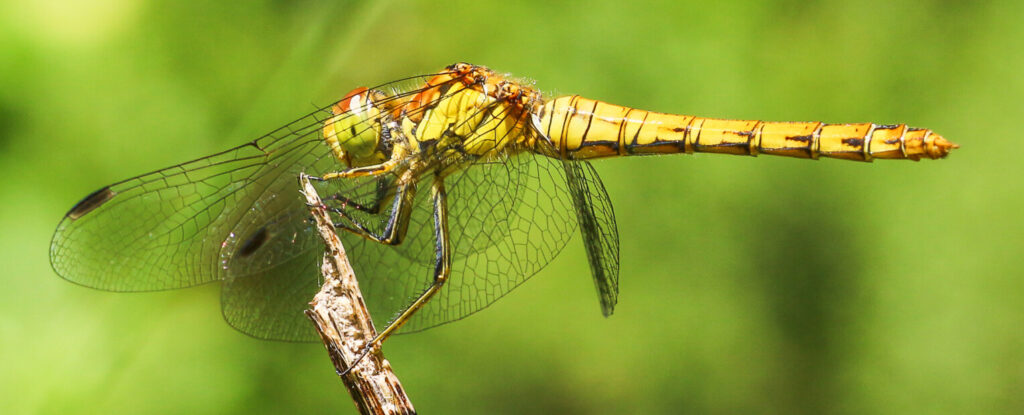
Whilst the males of both species have differences in colouring, shape and size – the Common Darter isslightly longer – care still needs to be taken to differentiate the two, particularly towards the end of theCommon Darter’s flight season. Both species start off in the ochre yellow colouring of the female, but themale Ruddy Darter soon takes on a red colouring. As it matures the colouring becomes a deep blood red.As the male Common Darter matures it also takes on a red colouring but never quite reaches the deep redof the Ruddy Darter. As in the females the legs are a good species indicator – the same yellow line runsdown the outside edge of the male Common Darter’s legs – although in very mature specimens this maynot be clearly visible; the Ruddy Darter’s are all black. Again close, careful examination is needed.Viewed from above the Ruddy Darter’s body has a club-like appearance. The Common Darter’s body hasonly slight narrowing. Neither female has such narrowing of the body. The thorax of the Common Darterhas two yellow panels; the Ruddy Darter’s is an unmarked reddish/brown – see images below.
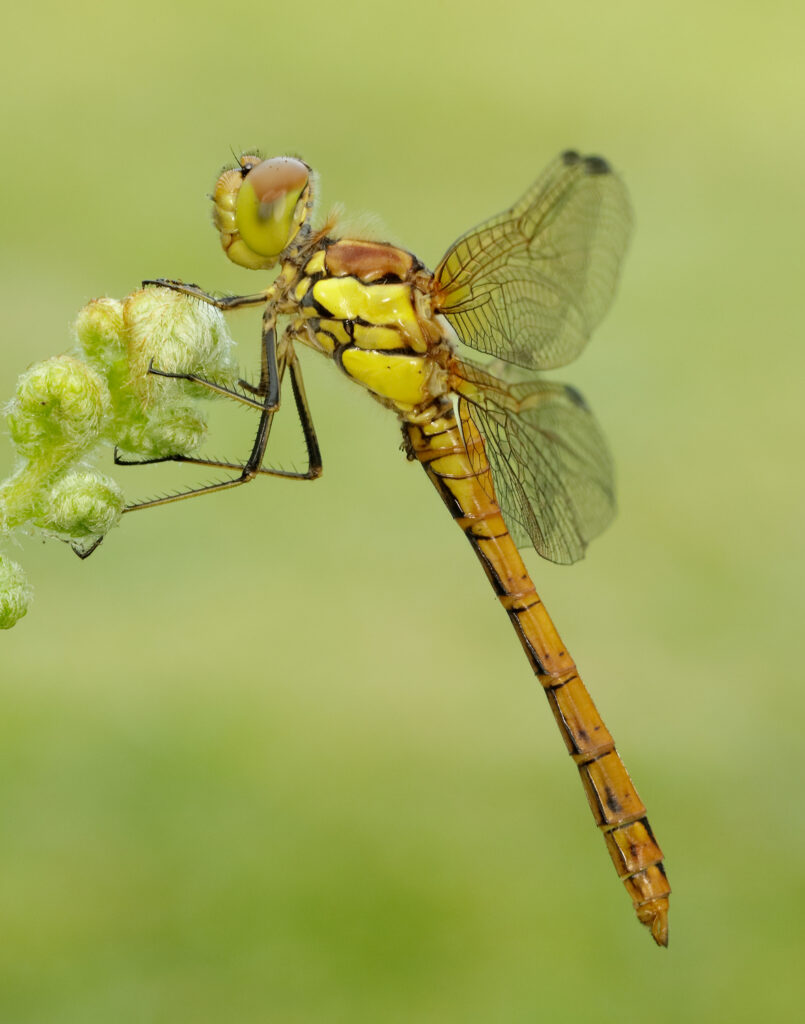
The common darter (Sympetrum striolatum) is a dragonfly of the family Libellulidae native to Eurasia. It is one of the most common dragonflies in Europe, occurring in a wide variety of water bodies, though with a preference for breeding in still water such as ponds and lakes. In the south of its range adults are on the wing all year round.
Sympetrum species are not easy to tell apart and in most areas more than one Sympetrum species will occur. Females and teneral individuals have light yellow thorax and abdomen. Males turn red as they mature. Females darken with age, becoming a dark chocolate brown, and sometimes develop a blue colouration to the bottom of the abdomen. The wings also develop a brown tinge with age. In all cases the legs have a cream or yellow stripe on a black background – this is a diagnostic feature of this species. The pterostigma of the females can be red, blue, pale blue or brown.
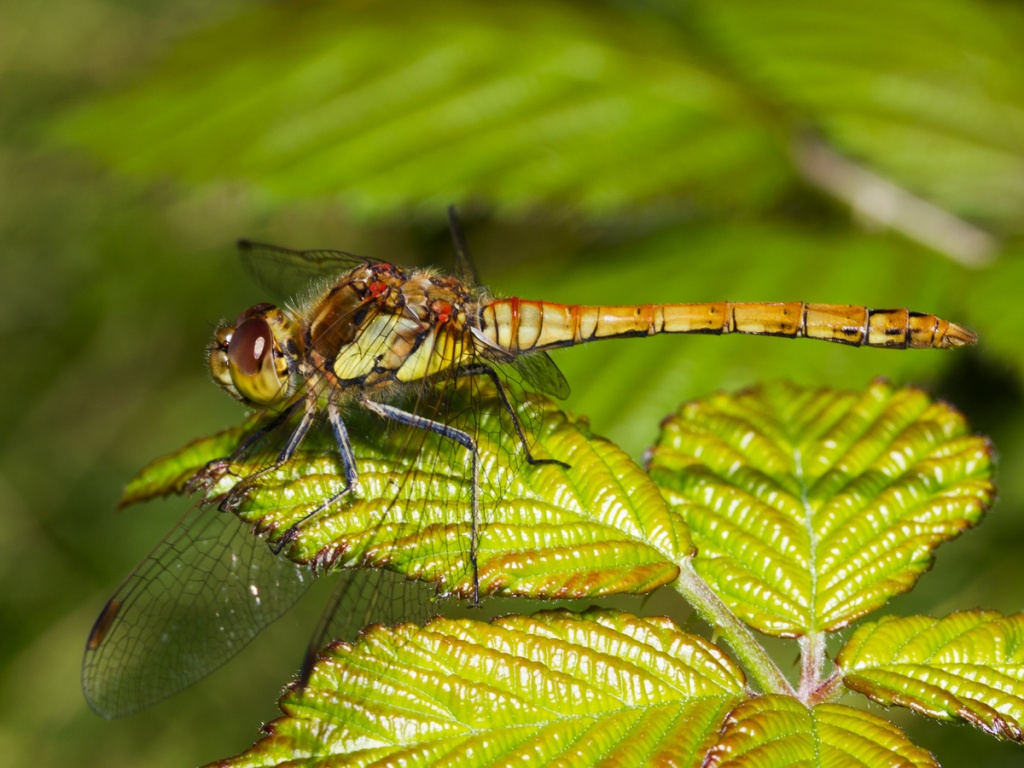
Adult Identification
- Length: 38-43mm
- Pale stripes on legs.
- Wing spots vary in colour.
- Black line at the top of the frons (faces) does not extend down the side of the eyes.
- Males: bright orange-red with yellow panels on side of the thorax.
- Females: ochre becoming duller/reddish with age.
- Immature adults: similar to females but paler.
The Common darter is a red, narrow-bodied dragonfly that can be seen throughout summer and autumn. It is hovers around all kinds of waterbodies, darting out to surprise its prey.
About
The Common darter is a small, narrow-bodied dragonfly that is typically on the wing from July to October, but can appear as early as May and still be around in December if its mild. This is a very common dragonfly, breeding in all sorts of waterbodies from ponds and ditches, to rivers and lakes. As their name suggests, Common darters dart forward suddenly from a hovering position to catch their insect-prey. They then take their catch to a favoured perch to eat it.
How to identify
Male Common darters are bright red, while the females and immature adults are golden-brown. There are several similar-looking red darters which can be very difficult to tell apart.
Did you know?
In the late summer, Common darters can be found almost everywhere, sat on twigs and fences, and angling their wings towards the sun to warm up.
How people can help
The Wildlife Trusts manage many wetland nature reserves for the benefit of the wildlife they support. You can help by supporting your local Trust and becoming a member; you’ll find out about exciting wildlife news, events on your doorstep and volunteering opportunities, and will be helping local wildlife along the way. Encourage dragonflies and damselflies into your garden by having a wildlife-friendly pond. To find out more about gardening for wildlife, visit our Wild About Gardens website: a joint initiative with the RHS, there’s plenty of facts and tips to get you started.
There are far more Common Darters than Ruddy Darters on show at Marsh Lane. If you see a redor yellow small to medium sized dragonfly at the height of summer presume it’s a Common Darterunless you can see the differences shown above. Of course there’s a very slim chance that you’vefound a migrant Red-veined Darter, a vagrant Black Darter, or something equally exotic!

